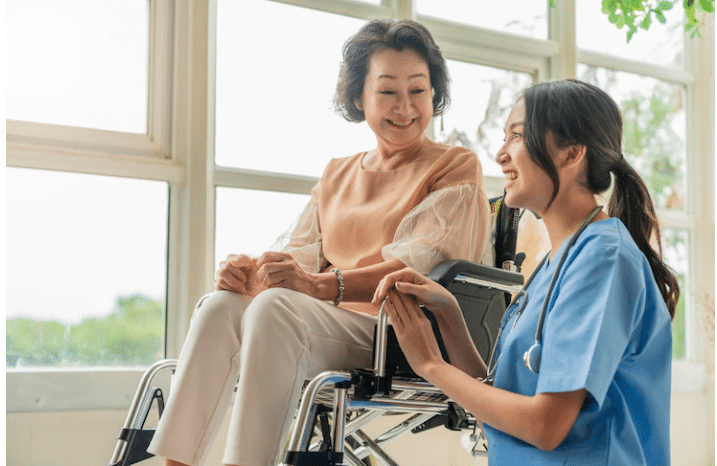Although not everyone is suited for the job, caregivers truly make a difference in the lives of their patients and their families. To succeed and deliver the best client care possible, caregivers must master a wide range of traits and abilities. To embrace and develop within that role and better serve our elderly population, it is crucial to understand the responsibilities and obligations of a senior caregiver. Find out below what functions and qualities you need to become a caregiver.
What Is A Caregiver?
A caregiver is a professional who provides care to those who require assistance in self-care. Children, the elderly, people with chronic illnesses, and people with disabilities are a few examples. Health professionals, relatives, friends, social workers, and members of the clergy are all examples of caregivers.
Additionally, their services, ranging from simple companionship to complex medical care, can be included in that care. Since the role and responsibilities of a caregiver’s job can change depending on the needs of the people they are responsible for, there really isn’t a fixed definition. Having said that, a generalized explanation of the various caregiver responsibilities and duties for our elderly population will give clarity and assurance to anyone who may hold that position in the future or who is already doing so.
What Does A Caregiver Do?
The duties of a caregiver can change at any time. The senior may need assistance moving from their bed to a chair the following week because even standing for a brief period is too much for them. This may happen on Saturday when you go grocery shopping with them. Understanding the variety of roles and responsibilities you might have to assume during your time as a caregiver is crucial because of this.
What Is The Role Of A Caregiver?
The main duties and responsibilities of a caregiver are:
#1. Preparing Meals
Meal preparation is a crucial component of caregiver responsibilities and tasks. To prepare simple meals for the elderly, you don’t need to be a top-notch chef. They will be able to prepare the snacks and meals they need to survive at home with the help of basic cooking skills. Since they won’t have to prepare the food themselves, having the meals ready can also prevent injuries.
#2. Nutrition
Maintaining a healthy and balanced diet is crucial for seniors, even in the absence of any specific dietary restrictions. Making sure that their nutritional needs are met is frequently a part of a caregiver’s responsibilities.
#3. Household Chores
Most of the caregivers regularly complete tasks like sweeping, mopping, sweeping, and doing the laundry with ease. These straightforward tasks become incredibly difficult for seniors.
#4. Caring For Pets
Caring for pets is important. Having a pet at home can significantly increase the quality of life and fight depression, especially for seniors. It can also help prevent the effects of elder isolation, making it a valuable part of caregiver duties.
#5. Hygiene
Personal hygiene is very important. Assisting seniors with bathing, dressing, and, if necessary, using the restroom will be a part of your caregiver’s responsibilities. A person’s dignity must be treated with compassion at all times.
#6. Shopping
A lot of people find shopping enjoyable. It can occasionally be nearly impossible for seniors to do it alone or at all. Runs to the store for groceries or other purposes help them fulfill crucial needs.
#7. Companionship
Since being there for them is likely more beneficial to their health than almost anything else, it makes perfect sense. You will have the chance to establish an extremely deep connection with someone through activities like watching television together or engaging in gossip.
#8. Medical Monitoring
Most elderly people will need to take some sort of daily medication. Making sure they have the right amount of medication and encouraging them to take it as prescribed by a doctor could be among your caregiver’s duties and responsibilities.
#9. Health & Fitness
Caregivers provide appropriate movements and exercises to improve a senior’s overall health by working within their limitations.
Finally, the assistance offered by a caregiver allows our senior population to remain contentedly in their own homes and is nothing short of a life-changing experience for them. All across the nation, there is demand for and availability of caregiver jobs. The positions are open-ended and waiting for people with a passion for helping others to fill them.
What Are The 5 Qualities Of A Good Caregiver?
#1. Patience
Patience is a crucial quality for caregivers because it enables them to deliver high-quality care without getting frustrated or overwhelmed. It is the ability to control one’s emotions and remain calm in difficult or frustrating situations. As a caregiver, they must be able to handle challenging situations with grace and calm.
#2. Active Listening
Active listening is an important skill for caregivers to effectively communicate with people they are caring for.
#3. Communication
Good communication is essential for caregivers to effectively communicate with their patients and build trust and rapport.
#4. Compassion
Compassion is being able to relate to another person’s suffering and be moved to act compassionately. For caregivers, being able to recognize and address the emotional needs of their patients is a fundamental skill.
#5. Emotional Stability
Emotional stability is an important skill for caregivers to have to remain calm and collected in stressful situations, such as caring for a sick or elderly person.
What Are The 10 Functions Of Caregivers?
Other essential duties and responsibilities include:
- Serving as a client companion and meal preparation
- Client transportation to and from appointments, errands, activities, etc.
- Interpersonal skills, such as patience and listening ability, are required.
- The ability to care for people in a variety of settings, such as group homes and day service programs.
- Performing housekeeping duties (e.g., cleaning the room, and laundry)
- Keeping accurate care records and informing the nursing team of any changes
- Promoting socialization and community involvement
- Communicating about care with families, coworkers, and supervisors
- Assisting with shopping and errand-running
- Keeping a secure and comfortable home environment
Types of Caregivers
Here we’ll cover the different types of caregivers.
#1. In-Home Caregivers
In-home caregivers provide services for different stages of caregiving, and the most common types are listed below.
#2. Family Caregivers
Family caregivers are unpaid family members who take care of a spouse or loved one, often related to the person receiving care. However, 20% of all caregivers work unpaid, but some can become paid through a home caregiving agency.
#3. Independent Caregivers
An independent caregiver is not associated with a caregiving agency and is employed directly by the family of the person who needs care. They collaborate with the family to determine the needs of their loved one’s care and offer all necessary caregiving services.
#4. Private Duty Caregivers
Private Duty Caregivers provide medical, nursing, cleaning, home, and transportation services to seniors, allowing them to continue living independently in their homes.
#5. Informal Caregivers
Informal caregivers provide similar services to family caregivers but are not related to the person receiving care, making them helpful for creating companionship.
#6. Professional Caregivers
Professional caregivers are career caregivers who work with a care recipient in their home or in a facility to ensure they receive proper care. They are typically assigned by agencies and provide homemaker services in addition to medical care.
#7. Hospice Caregivers
When a patient is nearing the end of their life, hospice caregivers are hired. The care recipient typically has a terminal illness of some kind. These caregivers perform the typical caregiving tasks but prioritize the client’s comfort and quality of life whenever it is practical.
#8. Virtual Caregivers
When a caregiver cannot physically visit the care recipient in their home for safety or health reasons, virtual caregivers can step in. Caregivers communicate with their patients via Skype or another type of video call using a tablet or other type of screen to make sure their health is being tracked.
In-home care should be supplemented with this kind of caregiving. Nevertheless, reminders for taking medications or conducting health checks still assist in providing care. It is beneficial for companionship as well.
#9. Adult Daycare Centers
Adult daycare is a great option for seniors who don’t do well in their home environment alone. It offers stimulating social, cognitive, and physical activity outside of the home for part of the day. It can be supplemented by an in-home caregiver if a family member has another job.
#10. Nursing Homes
Nursing homes provide a variety of rehabilitative therapies, medical assistance, and higher levels of aid than typical caregivers. They may be bedridden, have a physical or mental disability, have Alzheimer’s or dementia, or need more medical attention.
What Are The Tools Used In Caregiving?
These ten organizing tools will help you strike a balance between self-care and providing for others.
#1. Documentation
Gather important documents and keep them in a file box or safe to save time and stress later. Include contact information for family and friends, health insurance information, banking, and other financial information, a living will, a power of attorney, a medical power of attorney, a last will, and a timeline of your health history. Therefore, create a bookmark on your computer and install a password manager to safely store usernames and passwords.
#2. Medication Management
Almost one-third of adults in the US take at least five medications, and adverse drug events cause over 600,000 emergency room visits and over 100,000 hospitalizations each year. Therefore, to prevent a life-threatening emergency, create a medication log or spreadsheet to list each medication, its dosage frequency, number of refills, and refill date.
Additionally, include dietary supplements and over-the-counter medications, and bring a copy with you to doctor’s appointments. Use a daily pill organizer and set alarms for medication times. Store drugs in a safe place.
#3. Caregiver Calendar
The most crucial step you can take to organize yourself may be to create a planning calendar. You can quickly identify doctor’s appointments and other important events by using color coding. Another kind of caregiving calendar enables you to ask for assistance with specific responsibilities. You can track claims made by friends online.
Here are a few examples:
- Care Team Calendar
- Care Calendar
- Create a Care Community
How Do You Answer A Caregiver Interview Question?
You should brand yourself as an expert caregiver who is respectful, perceptive, dependable, and patient. Additionally, describe how you have performed in roles that required you to collaborate closely with others, adhere to strict policies and procedures, and exhibit understanding and empathy.
How Do You Respond To Difficult Clients As A Caregiver?
Regardless of how challenging clients act, it’s crucial to maintain composure at all times. Your ability to maintain composure will set a good example for other people and improve your reputation. You’ll also discover that you can communicate your ideas more effectively when you adopt a composed yet firm demeanor.
What Is A Caregiver Daily Checklist?
A caregiver’s daily checklist is a document that outlines, monitors, and summarizes every service a caregiver ought to offer to a person who requires constant observation. It includes a list of tasks that a caregiver should perform to assist a care recipient physically, mentally, and emotionally.
This tracking sheet can be used by paid, unpaid, or volunteer caregivers in nursing homes, adult daycare facilities, home healthcare facilities, and assisted living facilities. Patients of all ages can benefit from a caregiver’s daily checklist, though elderly patients tend to benefit the most.
How Do I Make A Caregiver Checklist?
#1. Learn about the recipient’s condition:
- Discuss any particular care requirements with their healthcare providers.
- Learn more about health topics from reliable websites and books on medicine.
- Ask about any unique caregiving skills you might need to pick up.
#2. Explore caregiving options:
- Not all of the patient’s particular requirements for meals, laundry, shopping, bathing, etc.
- Consult the care recipient, their family, or the healthcare professionals to learn how to meet those needs.
#3. Plan for immediate care:
- Involve the person receiving care in decision-making and ask them about their preferences for immediate care.
- Make accommodations in their home for wheelchairs, walkers, and other special needs equipment.
- Create a plan for monitoring their medical requirements, such as keeping a record of their dietary habits or medication usage.
#4. Organize important information:
- Note down the names, contact information, and medical terms for the patient’s ailments, as well as the names and dosages of any prescribed medications.
- Organize their financial data, such as their bank accounts, credit card statements, and insurance policies.
- Make copies of their insurance cards, social security numbers, and other crucial personal information.
#5. Plan for emergencies:
- Prepare for emergencies by ensuring there is a plan in place if the primary caregiver becomes ill or injured.
#6. Plan for the future:
- Learn about the long-term prognosis of the patient to help you plan your care more effectively.
- Consult an advisor who is familiar with the financial aspects of caregiving to assess your finances.
- Consult legal aid regarding a health care proxy.
- To plan family meetings and establish care expectations, enlist the assistance of a geriatric care manager.
What Is The Best Caregiver Course?
Basic supervision, personal care, behavior management, and caring for residents who are unable to direct their care, such as those with Alzheimer’s and dementia, are all covered in the National Caregiver Certification Course. It also covers other core essential areas of caregiving.
What is the Average Salary of a Caregiver?
In the United States, caregivers make an average of $16 per hour, whereas, in the United Kingdom, caregivers make an average of £10 per hour. Based on variables like years of experience, location, level of education, and industry, this number varies.
HOME HEALTH AIDE: All You Need to Know
The Role of Family Support in Student Mental Health and Well-being
BEST HEALTHCARE STOCKS – A Detailed Guide
MEDICAL OFFICE ASSISTANT: Job Description, Duties, Salary & Certification






